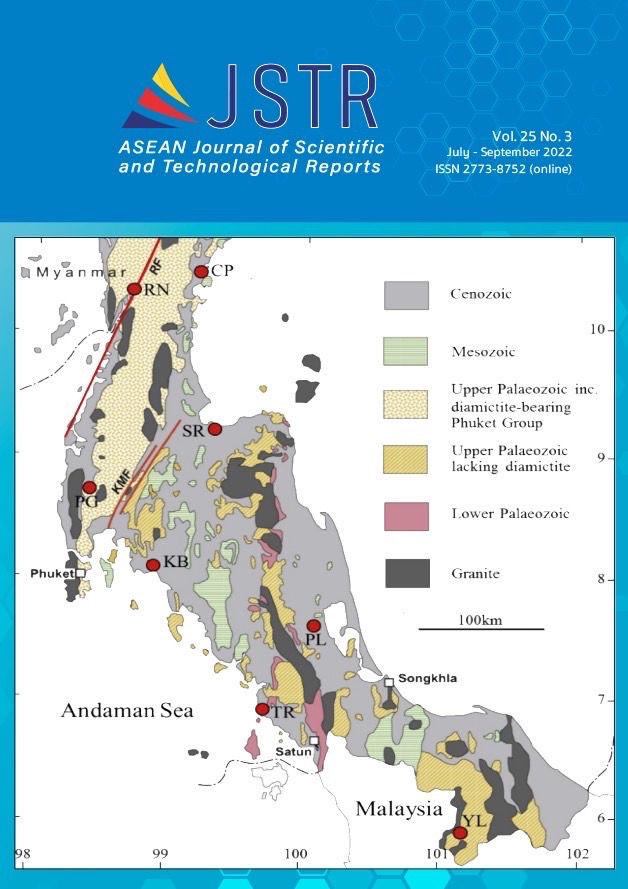Effects of Dietary Protein Levels on the Stage Development and Production Performance of Nile Tilapia
Main Article Content
Abstract
Lack of understanding in selecting age-appropriate protein levels in the tilapia diet would result in low growth and productivity. Therefore, the effect of dietary protein levels on tilapia development and the productive potential of fry raised in concrete ponds according to the CRD experimental protocol was investigated using three treatments with four replications. Fifteen breeder fish/ponds with a male-to-female ratio of 1:2 were fed with 15.5, 25, and 30% protein for 20 weeks. The water quality was monitored and the fish's mouth was tapped every 2 weeks. The results showed that feeding of 25% protein affected egg development at all stages (Zygote, Cleavage, Gastrula, Segmentation, Pharyngula, Hatching, Early larva, and Late larva) as well as production cost better than other feeds (p<0.05). Breeders fed 30% protein had a higher average weight, specific growth rate, condition factor, and feed efficiency but the lowest feed intake, feed rate, and feed conversion rate (p<0.05). A 25% protein diet provides adequate nutrition for hatching and fries production while keeping the pond water safe for their lives.
Article Details

This work is licensed under a Creative Commons Attribution-NonCommercial-NoDerivatives 4.0 International License.
References
FAO. The State of World Fisheries and Aquaculture, Rome, Italy, 2014, 223.
Tveteras, R.; Nystoyl, R. Fish Production Estimates & Trends 2011-2012, Global Outlook for Aquaculture Leadership (GOAL). Santiago. 2011, 57.
Department of Fisheries. Fisheries Statistics of Thailand 2017, No. 9/2019, Fisheries Development Policy and Strategy Division, Department of Fisheries, Ministry of Agriculture and Cooperatives, Bangkok, 2019, 92.
Bhujel, R.C.; Yakupitiyage A.; Turner W.A.; Little D.C. Selection of a commercial feed for Nile tilapia (Oreochromis niloticus) broodfish breeding in a hapa-in-pond system. Aquaculture. 2001, 194(3), 303-314.
Svobodová, Z.; Lloyd, R.; Máchová, J.; Vykusová, B. Water quality and fish health. EIFAC Technical Paper. No. 54. Rome, FAO. 1993, 59.
Chitmanat, C.; Makaw, S. Effects of protein levels and feed pellet types on the growth and production of red tilapia cage culture in Huai Pae reservoir, Tombon Naprang, Amphoe Pong, Phayao province. Proceedings of 48th Kasetsart University Annual Conference: Fisheries: 2010, 271-278. (in Thai)
Bhujel, R.C. On-farm feed management practices for Nile tilapia (Oreochromis niloticus) in Thailand. In; M.R. Hasan and M.B. New, eds. On-farm feeding and feed management in aquaculture. FAO Fisheries and Aquaculture Technical Paper No. 583. Rome, 2013, 159-189.
Al Hafedh, Y. S. Effects of dietary protein on growth and body composition of Nile tilapia, Oreochromis niloticus L. Aquaculture Research. 1999, 30(5), 385-393.
Popma, T.; M. Masser. Tilapia: Life History and Biology. SRAC Publication No. 283. Southern Regional Aquaculture Center, Stoneville, MS. 1999.
Sousa, S.M.D.N., Freccia, A.; Santos, L.D.D.; Meurer, F.; Tessaro, L.; Bombardelli, R.A. Growth of Nile tilapia post-larvae from broodstock fed diet with different levels of digestible protein and digestible energy. Revista Brasileira de Zootecnia. 2013, 42(8), 535-540.
APHA. Standard Methods for the Examination of Water and Wastewater. American Public Health Association. Washington, DC. 1989; 1, 268.
APHA. Compendium of methods for the microbiological examination of foods, 4th ed. American Public Health Association. Washington, D.C. 2001, 676.
Fujimura, K.; Okada N. Development of the embryo, larva and early juvenile of Nile tilapia Oreochromis niloticus (Pisces: Cichlidae). Developmental staging system. Development, growth and differentiation. 2007, 49(4), 301-324.
Surajit, T.; Yoonpundh, R.; Srisapoome, P.; Satienjitr, S.; Thaitungchin, C. Comparition study on breeding systems of nile tilapia (Oreochromis niloticus) fry production in earthponds, tanks and hapas suspended in an earthen pond. Proceedings of 47th Kasetsart University Annual Conference: Fisheries. 17-20 March 2009. Bangkok. 2009, 434-443.
Shaha, D.C.; Kundu S.R.; Hasan M.N. Production of organic grass carp (Ctenopharyngodon idella) and GIFT tilapia (Oreochromis niloticus) using napier grass, Pennisetum purpureum. Journal of Fisheries. 2015, 3(1), 233-238.
Tsadik, G.G.; Bart A.N. Effects of feeding, stocking density and water-flow rate on fecundity, spawning frequency and egg quality of Nile tilapia, Oreochromis niloticus (L.). Aquaculture. 2007, 272(1), 380-388.
Srisakultiew, P. Studies on the reproductive biology of Oreochromis niloticus (L.). Ph.D. thesis, Stirling: University of Stirling. Scotland. 1993, 310.
Cheng, Z.J.; Hardy R.W.; Usry J.L. Plant protein ingredients with lysine supplementation reduce dietary protein level in rainbow trout (Oncorhynchus mykiss) diets, and reduce ammonia nitrogen and soluble phosphorus excretion. Aquaculture. 2003, 218(1), 553-565.
Gan,L.; Liu Y.J.; Tian L.X.; Yang H.J.; Yue Y.R.; Chen Y.J.; Liang J.J; Liang G.Y. Effect of dietary protein reduction with lysine and methionnine supplementation on growth performance, body composition and total ammonia nitrogen excretion of juvenile grass carp, Ctenopharyngodon idella. Aquaculture Nutrition. 2012, 18(6), 589-598.
Evans, J.J.; Pasnik D.J.; Brill G.C.; Klesius P.H. Un-ionized ammonia exposure in Nile tilapia: toxicity, stress response, and susceptibility to Streptococcus agalactiae. North American Journal of Aquaculture. 2006, 68(1), 23-33.
El-Greisy, Z.A.E.B.; Elgamal A.E.E.; Ahmed N.A.M. Effect of prolonged ammonia toxicity on fertilized eggs, hatchability and size of newly hatched larvae of Nile tilapia, Oreochromis niloticus. The Egyptian Journal of Aquatic Research. 2016, 42(2), 215-222.


